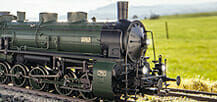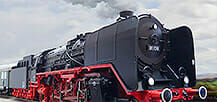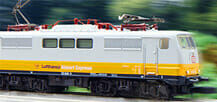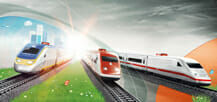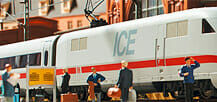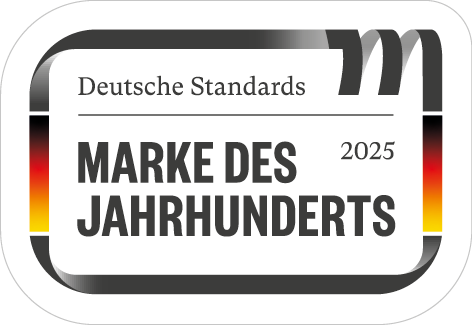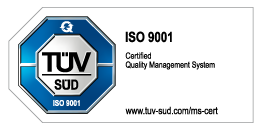Class 050 Steam Freight Locomotive with a Cabin Tender
Prototype: German Federal Railroad (DB) class 050 steam freight locomotive with a cabin tender. Witte smoke deflectors, 4 boiler domes, shortened running boards, DB Reflex glass lamps, and inductive magnets. Locomotive road number 050 045-4. The locomotive looks as it did around 1970.
Most Important Facts
Sound demo| Article No. | 37836 |
|---|---|
| Gauge / Design type | H0 / 1:87 |
| Era | IV |
| Kind | Steam Locomotives |
Check with your local dealer Find Dealer
Highlights
- Cab lighting digitally controlled.
- Lighting in the tender cabin digitally controlled.
- Figures of a locomotive engineer and a fireman included.
- Train conductor in the tender cabin.
- Especially finely detailed metal construction.
- Partially open bar frame and many separately applied details.
- High-efficiency propulsion with a flywheel, mounted in the boiler.
- mfx+ World of Operation decoder and extensive operational and sound functions included.
-
Product description
Model: The locomotive has an mfx+ digital decoder and extensive sound functions. It also has controlled high-efficiency propulsion with a flywheel, mounted in the boiler. 5 axles powered. Traction tires. The locomotive and tender are constructed mostly of metal. A 7226 smoke unit can be installed in the locomotive. The triple headlights change over with the direction of travel. They and the smoke unit that can be installed in the locomotive will work in conventional operation and can be controlled digitally. The cab lighting and the cabin lighting in the tender cabin can be controlled separately in digital operation. Maintenance-free warm white LEDs are used for the lighting. There is a figure in the tender cabin of a train conductor, installed at the factory. There is a close coupling with a guide mechanism between the locomotive and tender. The rear of the tender and the front of the locomotive have close couplers with NEM pockets and guide mechanisms. The minimum radius for operation is 360 mm / 14-3/16". Figures of a locomotive engineer and a fireman as well as protective piston sleeves and brake hoses are included.
Length over the buffers 26.5 cm / 10-7/16".Freight cars to go with this locomotive can be found in the current Märklin H0 assortment.
This model can be found in a DC version in the Trix H0 assortment under item number 22786.
Find more Märklin explanation videos on our YouTube Channel
Spare parts for our articles can be found here in our spare parts search.
-
Publications
- New items brochure 2017 - Product programme 2017/2018 - Product programme 2018/2019
-
Prototype information
The class 50 locomotive came into being shortly before the start of World War II as the last of the so-called "standard design steam locomotives". In April of 1937 the German State Transportation Ministry ordered the German State Railroad's central office (RZA) to develop a powerful freight locomotive for branch lines as a replacement among other things for the class 57.10-40 (Prussian G 10) 0-10-0 freight steam locomotives. They were planned to haul a medium freight train on level terrain, be able to negotiate curves with a radius of 140 meters / approximately 455 feet, and be usable with a 15 metric ton axle load on branch lines with light roadbed. A speed of 80 km/h / 50 mph appeared sufficient. Since many terminal stations had no turntable or the ones available were too short, these units had to be able to go equally fast in both directions. A protective wall for the tender was therefore planned to protect the locomotive crews. The RZA initially planned a 2-8-0 locomotive (class 46) because it was felt a 2-10-0 locomotive could not be trusted with the required high speed in reverse nor with the required drawbar performance. A 2-8-0 unit could not achieve the required axle load and the design remained a locomotive with five driving axles and a pilot truck. From April to July of 1939 Henschel built the first twelve locomotives with steel fireboxes, alloy steel as the material for the boilers, two-cylinder superheated steam running gear with a Wagner super heater, and 16 bar / 232 pounds per square inch boiler pressure. The class 50 thus developed was shortly destined to become the German State Railroad's most successful design, because this locomotive with its approximately 1,600 horsepower and 80 km/h / 50 mph speed quickly became a general-purpose, sturdy, reliable unit. The outbreak of war on September 1, 1939 caused a leap in the demand for freight locomotives, and the twelve pre-production locomotives were followed by another 3,152 units over the course of the next few years. Almost all of the European locomotive builders participated in the construction of these locomotives. Like the class 44, the class 50 was also simplified over the course of World War II so that locomotives were delivered starting in 1942 as the class 50 ÜK. Over 300 units were finally so simplified that they were designated as the class 52 wartime locomotive although they were originally planned as the class 50. Despite numerous losses during the war, there were almost 3,000 locomotives on the two German railroads after 1945. The DR had over 317 after transfers and retirements, and the DB had more than 2,000 units. The DB units were at home all over the German Federal Republic. They were equipped with Witte smoke deflectors, and the running board skirting was removed on most of the units. Starting in 1961, the tenders of 730 locomotives were equipped with cabins for the train crews in the course of rationalization and updating of service and operations. This reduced the coal capacity to 6.6 metric tons. The lower weight made these units more versatile and they replaced the tank locomotives in use on many branch lines. The introduction of computer numbers starting in 1968 turned the class 50 into the classes 050-053. They were among the German Federal Railroad's last steam locomotives and were in service until 1977.
-
Digital Functions
Control Unit Mobile Station Mobile Station 2 Central Station 1/2 Central Station 3/2*
Mobile Station 2**Headlight(s) Smoke generator contact Steam locomotive op. sounds Locomotive whistle Direct control Sound of squealing brakes off Light in compartment Bell Engineer’s cab lighting Whistle for switching maneuver Air pump / compressor Letting off Steam Sound of coal being shoveled Grate Shaken Water Pump Injectors Replenishing fuel Replenishing fuel Sanding Cab chatter Switching maneuver * New features of the Central Station 2 (Part No. 60213, 60214 or 60215) with the software update 4.2
** New features of the Mobile Station 2 (Part No. 60657/66955) with the Software Update 3.55
